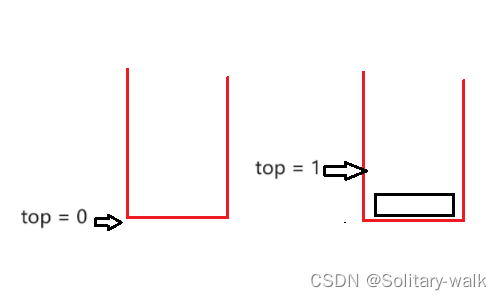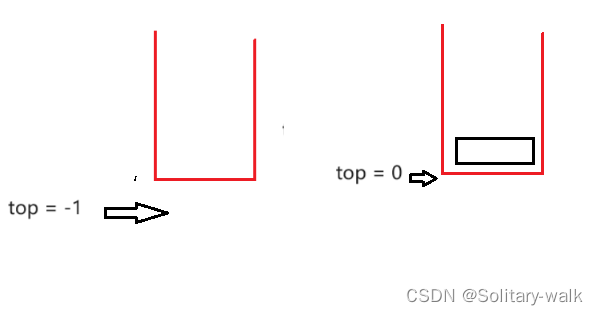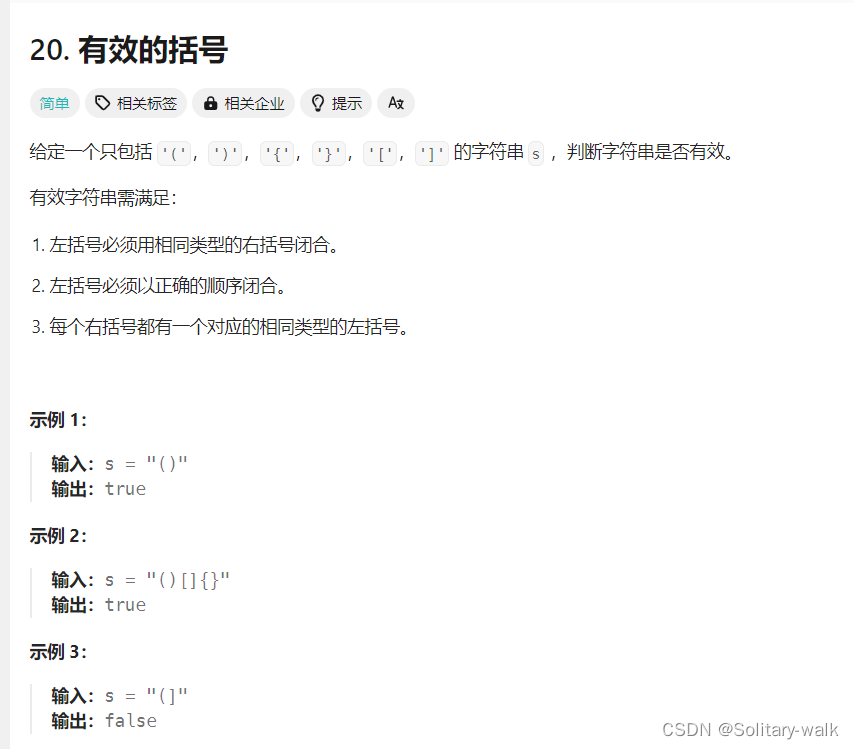𝙉𝙞𝙘𝙚!!👏🏻‧✧̣̥̇‧✦👏🏻‧✧̣̥̇‧✦ 👏🏻‧✧̣̥̇:Solitary-walk
⸝⋆ ━━━┓
- 个性标签 - :来于“云”的“羽球人”。 Talk is cheap. Show me the code
┗━━━━━━━ ➴ ⷯ本人座右铭 : 欲达高峰,必忍其痛;欲戴王冠,必承其重。
👑💎💎👑💎💎👑
💎💎💎自💎💎💎
💎💎💎信💎💎💎
👑💎💎 💎💎👑 希望在看完我的此篇博客后可以对你有帮助哟👑👑💎💎💎👑👑 此外,希望各位大佬们在看完后,可以支持一下。
👑👑👑💎👑👑👑
目录:
一:初始化
二:销毁
三:进栈(入栈 / 压栈)
四:出栈
五:获取栈顶元素
六:求栈中元素个数
七:判空
八:练习
栈的基本了解: 栈的概念和结构:

1:初始化
在对栈进行初始化之前需要先对栈这个结构进行定义一下
这里暂且就以 数组栈为例
typedef int STDataType;
typedef struct Stack {STDataType* a;//动态的int capacity;//容量int top;//记录栈顶位置
}ST;初始化:让 capacity = 0,至于 top 是为0 还是为 1,自行决定
void STInit(ST* pst)
{assert(pst);pst->a = NULL;pst->capacity = 0;pst->top = 0;//表示 top 指向栈顶元素下一个位置//pst->top = -1;//表示 top 指向栈顶元素的位置
}2:销毁
这个就很简单了,直接对 数组进行销毁即可
3:进栈(入栈 / 压栈)
注意: 初始化 top 的值 对进栈的操作很重要
top = 0 :top 指向栈顶元素下一个的位置

top = 0 ,此时进栈需要 先把数据插到 top 对应的位置,之后top++
top = 0 :刚好也可以表示 栈中数据元素个数为 0
top = -1 :top 指向 栈顶元素位置

top = -1:
进栈的操作:先让top++;再对top 所在地位置进行插入数据
void STPush(ST* pst, STDataType x)
{assert(pst);//空间检查if (pst->top == pst->capacity){int newcapacity = pst->capacity == 0 ? 4 : pst->capacity * 2;STDataType* tmp = (STDataType*)realloc(pst->a, sizeof(STDataType) * newcapacity);if (tmp == NULL)return;//成功pst->a = tmp;pst->capacity = newcapacity;}pst->a[pst->top] = x;pst->top++;//指向栈顶元素下一个位置
}4:出栈
直接一步到位即可;让top - -
注意不是 top -1
void STPop(ST* pst)
{assert(pst);assert(!STEmpty(pst));//判空pst->top--;
}5:获取栈顶元素
STDataType STTop(ST* pst)//获取栈顶元素
{assert(pst);return pst->a[pst->top-1];// 注意top 永远指向栈顶元素下一个位置
}6:求栈中元素个数
int STSize(ST* pst)//求栈中元素个数
{assert(pst);return pst->top;
}7:判空
bool STEmpty(ST* pst)
{assert(pst);/*if (pst->top == 0){return true;}elsereturn false;*/return pst->top == 0;//不用三目操作符
}完整代码:
test.c
#define _CRT_SECURE_NO_WARNINGS 1
#include"stack.h"void test()
{ST st;STInit(&st);STPush(&st, 1);//STPrint(&st);//注意没有这种写法//对于栈的访问都是边访问边出栈STPush(&st, 2);STPush(&st, 3);STPush(&st, 4);STPush(&st, 5);STPush(&st, 6);int size = STSize(&st);while (!STEmpty(&st)){printf("%d ", STTop(&st));//获取栈顶元素STPop(&st);//出栈}STDestroy(&st);}
int main()
{test();return 0;
}Stack.c
#define _CRT_SECURE_NO_WARNINGS 1
#include"Stack.h"void STInit(ST* pst)
{assert(pst);pst->a = NULL;pst->capacity = 0;pst->top = 0;//表示 top 指向栈顶元素下一个位置//pst->top = -1;//表示 top 指向栈顶元素的位置
}
void STDestroy(ST* pst)
{assert(pst);free(pst->a);pst->a = NULL;
}void STPush(ST* pst, STDataType x)
{assert(pst);//空间检查if (pst->top == pst->capacity){int newcapacity = pst->capacity == 0 ? 4 : pst->capacity * 2;STDataType* tmp = (STDataType*)realloc(pst->a, sizeof(STDataType) * newcapacity);if (tmp == NULL)return;//成功pst->a = tmp;pst->capacity = newcapacity;}pst->a[pst->top] = x;pst->top++;//指向栈顶元素下一个位置
}
void STPop(ST* pst)
{assert(pst);assert(!STEmpty(pst));//判空pst->top--;
}STDataType STTop(ST* pst)//获取栈顶元素
{assert(pst);return pst->a[pst->top-1];// 注意top 永远指向栈顶元素下一个位置
}int STSize(ST* pst)//求栈中元素个数
{assert(pst);return pst->top;
}bool STEmpty(ST* pst)
{assert(pst);/*if (pst->top == 0){return true;}elsereturn false;*/return pst->top == 0;//不用三目操作符
}Stack.h
#pragma once
#include<stdio.h>
#include<stdlib.h>
#include<assert.h>
#include<stdbool.h>typedef int STDataType;
typedef struct Stack {STDataType* a;//动态的int capacity;//容量int top;//记录栈顶位置
}ST;void STInit(ST* pst);
void STDestroy(ST* pst);void STPush(ST* pst, STDataType x);
void STPop(ST* pst);STDataType STTop(ST* pst);//获取栈顶元素int STSize(ST* pst);//求栈中元素个数bool STEmpty(ST* pst);8:练习

刚刚好学了栈,那咱就趁热打铁练习一下
分析:
当是左括号中的 { ( [ 任一个,我们就进栈 ;若是出现对应的右括号中的任一个我们就去栈顶元素进行匹配 若是 左右括号不能匹配成功则 return false;
结语:
以上就是我今日要share 的,总体来说很简单相较于链表那块,轻松拿捏,同时在今天这个特别 的日子里也是祝愿大家新春快乐,在新的一年里快快乐乐,在学习上工作上一帆风顺

汉明距离)


)
)
)



)



函数详解)
——Findings论文解读)



